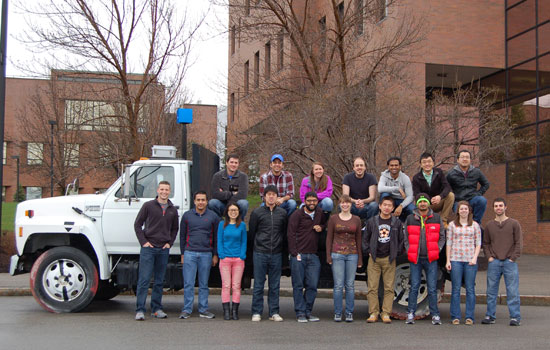System helps drivers be on the lookout for deer
The cohort of imaging science Ph.D. students finishing its first year in the Chester F. Carlson Center for Imaging Science will exhibit a deer-alert system at Imagine RIT on May 3. Shown in the top row, left to right, are Doug MacDonald, Kamran Binaee, Brittany Ambeau, Kevan Donlon, Viraj Adduru, Zichao Han and Yue Wang. In the bottom row, left to right, are Justin Harms, Utsav Gewali, Jie Yang, Yansong Liu, Osborn de Lima, Kelly Anderson, Zhaoyu Cui, Shusil Dangi, Lauren Taylor and Colin Axel. Not shown is Chi Zhang.
The concept for a high-tech deer-alert system that could make nighttime driving safer will be on display in the Gordon Field House during Imagine RIT on May 3.
First-year Ph.D. students in the Chester F. Carlson Center for Imaging Science built a long-range infrared dual camera system to warn drivers of deer in their vicinity. The project was assigned to the cohort with the Imagine RIT: Innovation and Creativity Festival on May 3 as a deadline.
“A big problem in the Northeast is the frequency of cars hitting deer, often between 1 and 3 a.m.,” said Roger Dube, professor in the Center for Imaging Science and facilitator of the introductory class for incoming Ph.D. students. “Our vision at night is limited to the region exposed in the headlights, which is at most a couple of hundred feet. At normal driving speeds, this doesn’t give the driver enough time to react.”
Working in teams, the students designed and built a system to see in the dark and warn the driver of nearby deer. Their proof of concept—tested on a big truck—integrates subsystems that collect data with thermal infrared cameras, process the imagery and communicate the proximity of deer within a quarter mile of the vehicle.
The system begins with two thermal infrared cameras mounted on top of a vehicle. The cameras, pointing in opposite directions, read information at far infrared wavelengths and detect heat given off by living things. “Hot” signatures are juxtaposed to the “cool” fingerprints of trees, buildings and other inanimate objects in the surroundings.
The students’ algorithms process images capturing heat from the deer’s bodies. These hot areas in the image are extracted from the background and matched to the templates of deer images the students created.
If there’s a positive match, the deer’s location is passed to a communication system comprised of speakers and 12 lasers mounted on the back of the vehicle with corresponding reflective dots on the windshield.
“The speaker will start beeping faster as you get closer to the deer and the dots with lasers will align where the deer is so the driver doesn’t have to take his eyes off the road,” said Colin Axel ’13 (B.S., imaging science), a Ph.D. student from Rochester. “The whole point is that we don’t want to take the driver’s eyes off the road at the moment when it is most important for them to pay attention.”
The team of Ph.D. students will display the project in subsystems at their booth in the Gordon Field House. They will demonstrate each of the components that create the overall system.“We will have a controlled demonstration of how the whole system operates,” said Justin Harms, a Ph.D. student and a U.S. Air Force officer from St. Louis. “We will also have other experiments using color and thermal cameras, where you can grasp the concept of looking at something not by its color but by how hot it is. You won’t see the room as you would normally see it; you see it as how hot or cold it is.”
The cohort of imaging science Ph.D. students who worked on the deer-alert system includes Doug MacDonald, Kamran Binaee, Brittany Ambeau, Kevan Donlon, Viraj Adduru, Zichao Han, Yue Wang, Justin Harms, Utsav Gewali, Jie Yang, Yansong Liu, Osborn de Lima, Kelly Anderson, Zhaoyu Cui, Shusil Dangi, Lauren Taylor, Colin Axel and Chi Zhang.








